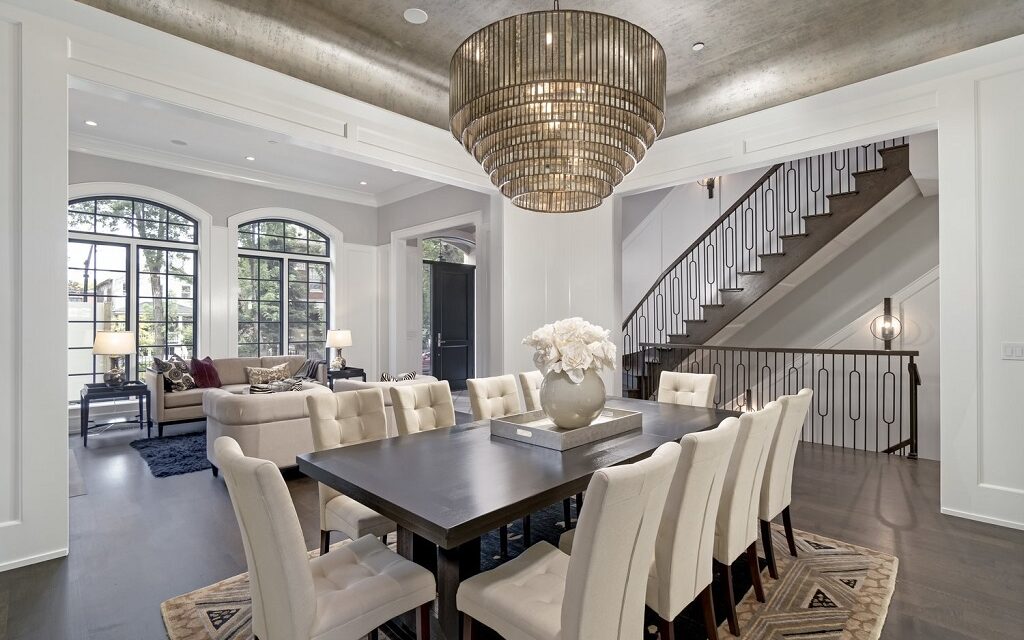The main image is courtesy of The Soundproofing Company, which showcases a luxury condo unit that was part of an extensive soundproofing project done for Barrett Homes.
Many years ago we lived in a newly constructed high-rise in San Francisco that boasted state of the art everything. Unfortunately, the one issue that the technology capital of the world could not solve was preventing sound transference between adjacent units.
The next door neighbor was undergoing a romantic breakup and played Bette Midler’s Wind Beneath My Wings on an endless loop. After what seemed to be the 100th start to the song, we called building management to let them know that our situation had become ridiculous.
We pleaded to know, “What could be done to improve the soundproofing with our shared wall???”
How do you soundproof a multifamily residential building, post construction? With so much engineering abound, surely in the 21st century we have mastered the art of soundproofing today’s modern structures.
“Of all the things to get upset about when living close to others, sound issues seem to be among the most incendiary” – Chicago CooperatorNews
In our case, fortunately, the use of acoustical caulk and rubber insulation dramatically reduced the noise that had been leaking through an edge of a shared wall that abutted large windows.
As every situation can vary, here are key concepts to understand and cost-effective solutions to help you mitigate your noise situation that are proven to work in some of the worst acoustical residential constructions.
Note: Though this article focuses on the unique challenges of mitigating noise issues in condominiums, the soundproofing methods and products shared are also applicable for soundproofing needs in single family homes, such as for home offices, home theaters, media rooms and guest bedrooms.
Table of Contents
- Principles of Soundproofing
- Benefits of Soundproofing
- How to Collaborate with Your HOA and Neighbors
- Steps to Effecting a Solution
- Encouraging Tips from an Acoustical Expert
- Soundproofing Diagrams & Videos
- Condo Noise Reduction Case Studies
- Soundproofing Resources
Also see:
Principles of Soundproofing
Soundproofing involves keeping sound energy within the confines of a space by preventing soundwaves from either entering or leaving the boundaries of walls, ceilings and flooring. This can be achieved by increasing the density of the materials that act as separation between two units, such as walls, ceilings and flooring.
“If you can clearly hear your neighbors’ conversations or TV through your walls or ceiling, you have a noise problem” – Chicago CooperatorNews
In building with shared walls, such as condominiums, townhomes and apartments, structure borne noise is the biggest issue, as sound energy moves through ceilings, flooring and walls from adjacent units. Similar to water, sound waves will leak through any available opening, such as:
- Doors
- Windows
- Electrical Outlets
- Air Vents, and
- Ceiling Light Fixtures
Airborne noise, such as a voice from the other side of the wall can permeate through solid walls, floors and ceilings, as sound energy can move through the “solid” infrastructure of sheetrock and wood framing. This sound energy is reflected into the unit on the other side of the wall to create noise at an audible decibel in your space. Complete 100% soundproofing would prohibit the reflection of sound energy from entering the other side of the wall, floor or ceiling.
Put another way, soundproofing solutions prevent the sound energy from escaping or entering across an adjacent space, much like a waterproof vessel can contain water without losing a drop. Sound acoustic treatments help by “containing” the sound energy within the confines of the room using dense, airtight materials that block sound energy.
This video from Acoustical Surfaces presents an easy, intuitive way to understand how to reduce the level of sound waves from entering an adjacent room.
There are four elements of soundproofing:
- Decoupling
- Break the path of vibration (e.g. cut the string between two “telephone cans”)
- Absorption
- Reduce how much sound resonates in air cavities with low-density insulation
- Mass
- Make it harder for sound to move a wall or surface by making it heavier
- Damping
- Dissipate vibrations between two adjacent rigid layers by converting sound energy into small amounts of of heat (e.g. apply Green Glue between two pieces of drywall)
Distance is also mentioned as an element of soundproofing, as sound waves weaken the farther they travel. However, this element is impractical for most residential noise situations.
Benefits of Soundproofing
Regardless of your current situation, find encouragement in the fact that there are many products and solutions that can help remedy even the most egregious situations of loud neighbors and poorly insulated buildings.
Though there will likely be restrictions and rules, imposed by your HOA, necessary to implement the most effective solutions, these hurdles will all be worth surmounting in terms of two key benefits:
- Improved Quality of Living
- Increased Market Value
“Condominiums with reputations for superior noise and vibration isolation have greater property value and attract higher real estate prices by adding a premium feel to each unit” – Walls & Ceilings
We strongly urge leveraging these two benefits as a means to foster cooperation and impact positive change throughout your building and HOA community. There is also the additional benefit of cost-savings, if you are able to recruit other homeowners (especially those adjacent to your unit) to hire the same professional service company in tandem.
If you are struggling to justify or allocate an adequate budget for fixing your noise issues, keep these highly valuable soundproofing benefits in mind:
- Increased Acoustic Privacy
- Improved Mental Health & Concentration
- Improved Sleep
- Increased Productivity, especially for Home Offices
- Increased Property Value & Buyer Interest
- Greater Personal Freedom & Increased Enjoyment
- Improved Relationships with Neighbors and HOA Board
Lastly, we anticipate that acoustic privacy advances being made in commercial office settings will migrate aggressively to residential settings, especially with the dramatic increase of Work-From-Home (WFH) professionals over recent years.
In parallel, we expect to see public awareness around acoustic privacy to grow exponentially over coming years, as there will be legal privacy issues and liability concerns propping up with such a large and growing WFH workforce.
Here is a highly illustrative video from JAD Soundproofing that demonstrates both the effectiveness of soundproofing and the importance of acoustic privacy in work-related situations.
JAD Soundproofing: Does Soundproofing Actually Make a Difference?
How to Collaborate with Your HOA and Neighbors
Since the purpose of this article is to help you find a pathway to the best solutions for your noise remediation, we recommend reaching out to your HOA and neighbors to build awareness and foster buy-in for empowering action. It is also imperative to understand the guidelines you must follow when planning upgrades to your unit.
First, your HOA can help you in situations where you have been negatively impacted by changes made to a neighbor’s unit. An example would be if the upstairs neighbor put in new flooring without adhering to proper building codes, which caused more sound to leak into your unit.
When dealing with your HOA, this example is important to keep in mind how HOA rules can help maintain the overall value and quality of a condo community, especially as homeowners make adjustments to their units over time.
Second, if you feel that your situation is largely due to inadequate construction of the original building, know that many condo communities have been able to remedy solutions to the betterment of all. Though this type of situation will be more challenging and time-consuming, it is definitely possible to overcome. Communities in most need of this kind of solution often involve the conversions of old, historical industrial buildings, like warehouses, that were originally not intended for residential living.
Lastly, and most important, there are professional-grade solutions that you can implement solely in your unit that can make a remarkable difference. Additionally, if you are able to recruit adjacent neighbors to join your project (especially your neighbor directly above), this collaboration will dramatically increase the sound improvements you will experience.
“Loud floors make for unhappy condo neighbors” – The Soundproofing Company
Steps to Effecting a Solution
- Hire an Acoustical Science Expert
- Collaborate with Your Neighbors
- Agree on a Solution
- Monitor the Project with the Expert
Hire an Acoustical Science Expert
Hiring an expert whose life’s work has been devoted to solving this issue of soundproofing is the correct and necessary approach. HOA association boards and their members are typically not experienced at solving structural noise abatement issues. Case study after case study illustrate that even developers have a spotty track record of noise reduction construction and soundproofing. External acoustic specialists can also serve the valuable role of being a neutral third-party looking to resolve the issue objectively, without needing to defend previous work, decisions or policies.
When reaching out to an expert, be prepared to share details on the following three questions:
- What noises are you hearing?
- Type of noises: voice, TV, footsteps, plumbing, doors, outside, etc.
- Where are you hearing noises?
- Closer to the floor? Louder near a window?
- When are you hearing these noises?
- Could it be an HVAC system turning on? Plumbing issue? Has it developed suddenly? Was there a change in an adjacent unit? How long has the noise been audible?
Companies, such as The Soundproofing Company with over 35 years of experience, offer a free consultation to help homeowners understand what they need to solve their noise issues. In the case of The Soundproofing Company, their business model is based on product sales, including acoustic specialty products and materials recommended in their detailed project specifications. They also call out materials and quantities that should be purchased locally at a nearby hardware store, such as gypsum drywall.
JAD Soundproofing offers a free virtual soundproofing inspection, as well.
In projects like noise abatement, experience is critical as seasoned specialists will have “seen it all” and will make sure that critical details of the implementation are correct. The best sound professionals know that incorrect installation can degrade the performance of resilient channel solutions, and unfortunately, that this problem is all too common.
Collaborate with Your Neighbors
Even if the noise from above or next door has created an untenable situation with a neighbor, it’s still possible to “make up” and become collaborative partners. When not on civil speaking grounds with your adjacent neighbors, we recommend seeking a third-party to mediate a mutually beneficial solution. A reputable sound insulation professional with experience remediating condos can likely offer guidance in this area.
Do not be surprised if a neighbor, with whom you have had a highly combative relationship, jumps at the chance to put these issues behind them once and for all, when presented with a viable solution!
Also see:
Agree on a Solution
With a neutral third-party’s assessment and remediation plan, you and your neighbor have all of the information you need to resolve your acoustical concerns. Good acoustical or soundproofing companies will even suggest ways to portion the costs equitably, especially if the situation involves a shared floor-to-ceiling solution.
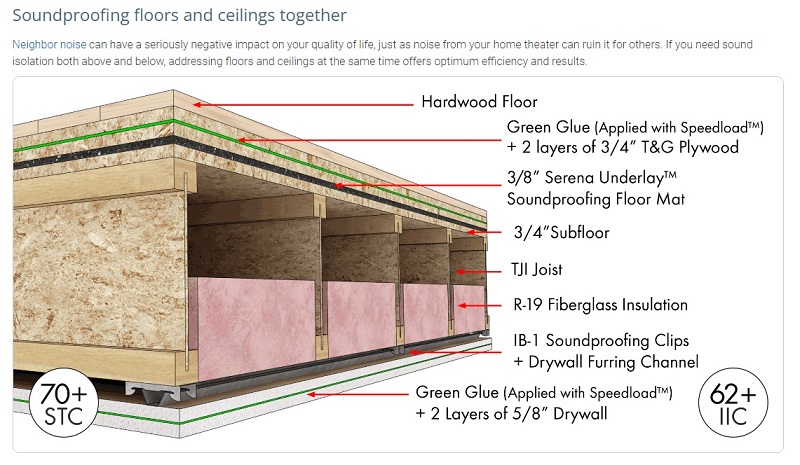
The Soundproofing Company’s ideal floor and ceiling combined soundproofing layers.
Possible when neighbors work together to achieve an optimal resolution.
In this common situation, an effective method of collaboration would be for the downstairs neighbor to agree to pay for the sound insulation layering of the upstairs neighbor’s flooring. The upstairs neighbor would just need to pay for the top presentation layer (e.g. hardwood, laminate or carpeting).
In turn, the downstairs neighbor benefits from a greater reduction in sound, while the upstairs neighbor gets new flooring at a reduced price – a true win-win situation! Most importantly, both owners benefit from creating quieter units that are now more valuable!
Monitor the Project with the Expert
Depending on the type of expert you hire (e.g. local in-person, or remote virtual), you may need to hire a dry wall professional that would implement the project specs, in the case of using a remote service like The Soundproofing Company.
Besides specifying the details and selling necessary specialty supplies and materials of a given project, the Soundproofing Company also works closely with the homeowner and dry wall professionals to insure each step is done correctly. They stay involved until “the paint is dry”.
Critical to working with a remote acoustics expert and an on-site dry wall pro, is to provide the acoustic expert with photo and video updates throughout the process to ensure installation is correct and how to handle unforeseen obstacles. For example, a key step in the process is for the expert to see what’s in the opened and exposed ceiling area to confirm if any adjustments to the original plan are necessary.
Regarding a standard ceiling project for a one bedroom condo, The Soundproofing Company does work directly with homeowners who are proficient DIYers – specifically if they have hung drywall before.
Encouraging Tips from an Acoustical Expert
Here are several tips we gathered during a recent phone call with acoustic expert Ted White, co-founder of The Soundproofing Company, which can help you set more realistic expectations and deeper understanding of options:
- The most common noise complaint situation is from a downstairs resident complaining about noise from the residence above
- The primary focus of your noise remediation should be on isolating the floors and ceilings between neighbors
- If not residing on the top floor, you should prioritize on remedying your ceiling first
- Recent trends have made indoor noise issues more prominent – e.g. significantly more time spent at home, combined with homeowners preferring to remove carpeting for hardwood or laminate flooring
- The supplies and materials for retrofitting a condo unit are relatively inexpensive, as labor for dry walling will be the largest portion of the cost (e.g. 2 to 3 times the cost of the materials). The ballpark total cost of retrofitting the ceiling of a 1,000 square foot condo unit would be in the $5K range.
- Retrofitting floors can be challenging, as the raised floor height can interfere with the layout of the residence (e.g. doorways, cabinet doors), so plan carefully
- Keep in mind that HOAs are not acoustical experts and may have sound standards that “don’t make sense” in the eyes of seasoned sound professionals
- It is not uncommon to receive resistance from HOA boards when seeking support or action regarding noise complaints, but do not be discouraged, as you will still have a lot of options to remedy your situation
- It can be challenging (i.e. rare) to win a dispute that would require the original builder to remediate acoustic deficiencies, as building codes tend to be minimal in terms of sound insulation requirements
- Customers also contact acoustical experts before buying a condo to assess if a unit can be properly insulated
- Do not be intimidated by complex terminology or persuaded into overpaying for a viable solution. The best specialists know that this is a straight-forward process with proven methods and parts that will get the job done right!
- Collaboration with neighbors really works, as both parties will be anxious to find a solution that can put all of the ugliness behind them!
To further your knowledge of best-practices for quality acoustic privacy in multifamily buildings, we highly recommend reading this collection of acoustic privacy construction tips from Building Design+Construction.
“Be aware that building to code may not be good enough. Building codes offer little in the way of acoustic privacy. From an acoustics standpoint, our expert panelists agreed, building to code is like getting a D on a test. Don’t rely on conformance to codes alone to achieve acceptable acoustic performance”. – Building Design + Construction
Soundproofing Diagrams & Videos
Shared-Wall Soundproofing Layering From Least Effective to Most Effective
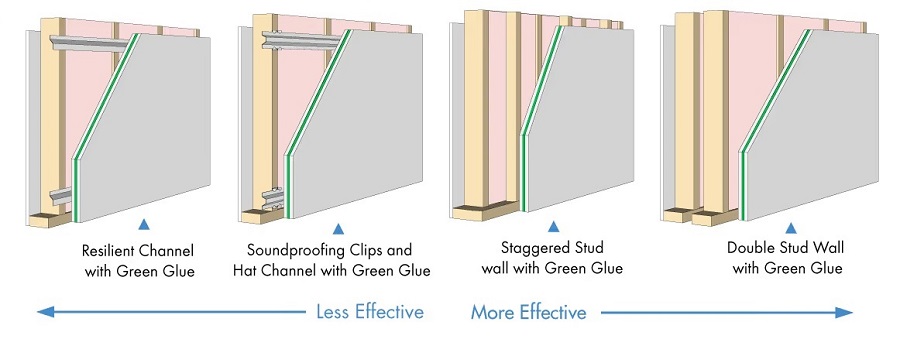
Image courtesy of The Soundproofing Company.
Diagram of a Typical Ceiling Without Additional Soundproofing
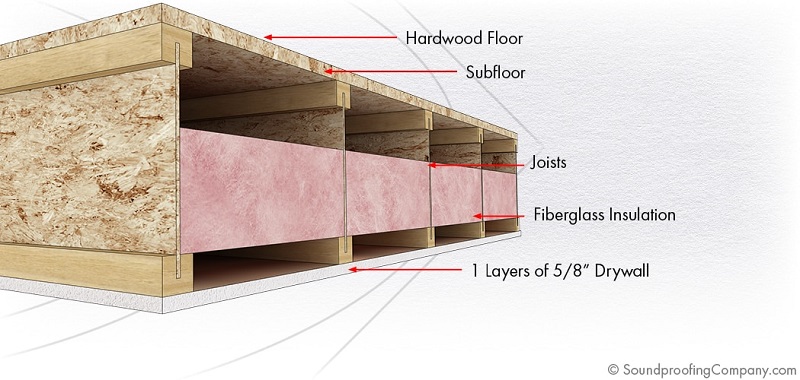
Diagram of a typical single drywall ceiling. Image courtesy of The Soundproofing Company.
Ideal Ceiling Insulation Without Access to Upper Unit Flooring
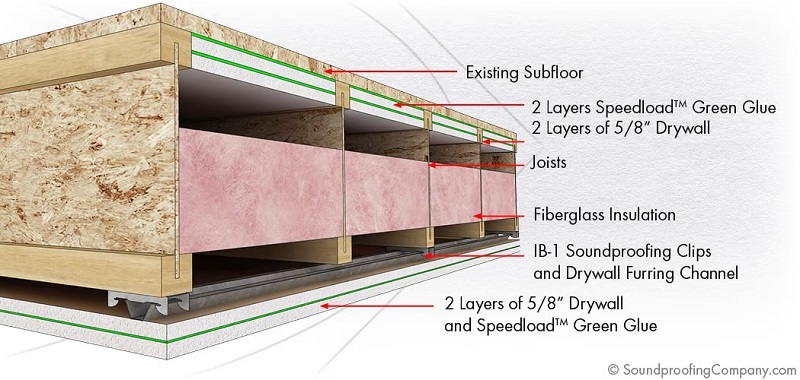
Image courtesy of The Soundproofing Company.
Ceiling Soundproofing Comparison Diagram: Good, Better, Best
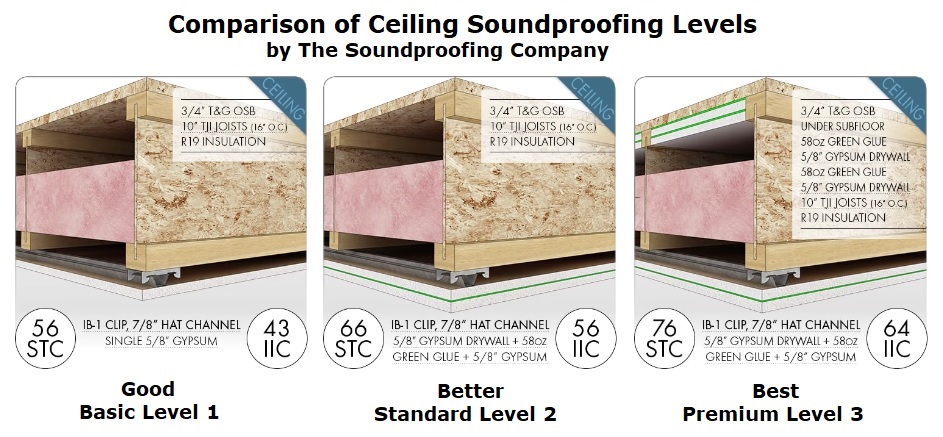
Image courtesy of The Soundproofing Company.
Video Demonstration of Soundproofing an Existing Ceiling
Soundproofing an Existing Ceiling in a Room by Trademark Soundproofing
Condo Noise Reduction Case Studies
- Boardwalk Condos Quiet Neighbor Noise Between Walls
- Burj Khalifa Luxury High Rise Building in Dubai
- Green Glue Gets the Job Done for Okemos Townhomes
- Impact Noise in Condos: An Interview with an Acoustic Consultant (part 1 of 3)
- Impact Noise in Condos: An Interview with an Acoustic Consultant (part 2 of 3)
- Impact Noise in Condos: An Interview with an Acoustic Consultant (part 3 of 3)
- Isolating Condominium Noise: A Case Study
- Los Angeles Luxury Apartment Building Solves Street Noise with Soundproofing Windows
- The Lucas: A Condo Conversion of a 19th Century Boston Church
- Soundproof Floor Solves Chicago Condo Developer’s Noise Problems
- The Soundproofing of an Orlando Condo
- The Soundproofing of a New Orleans Condo Building
- Soundstop.co.uk Customer Soundproofing Case Studies
- SPC Helps Atlanta High-Rise Solve Residents’ Noise Complaints
- Water Crest Condominiums Deliver Quiet Living in Madison, Wisconsin
SoundProofing Resources
Soundproofing Companies & Stores
- Acentech
- Acoustical Solutions
- Acoustical Surfaces
- AcoustiGuard
- AcoustiTECH
- IsoStore
- JAD Soundproofing
- Residential Acoustics
- Sound Proofing America
- Soundproof Cow
- The Soundproofing Company
- Soundspot.co.uk
- Trademark Soundproofing
Soundproofing Products
- Acoustic Door Seals
- Acoustic Door Sweeps
- Acoustical Caulk: Green Glue Noiseproofing Sealant
- Acoustical Putty Pads for Electrical Outlets
- Active Noise Control for Home Appliances: Silentium
- Green Glue Noiseproofing Compound
- Isolated Recessed Lighting: QuietBox
- IsoTrax™ Sound Isolation System
- Mass Loaded Vinyl
- Owens Corning 703 Insulation for Acoustic Panels
- Quiet Barrier™ HD Soundproofing Composite
- Quiet Barrier™ with Peel-and-Stick Backing
- QuietRock Sound Reducing Drywall
- Resilient Sound Clips
- The RSIC-1 Resilient Sound Isolation Clip
- Rubber Underlayment for Floors
- Seal for Soundproofing Outlet & Light Boxes
- Sheetrock® Brand Firecode® Smoke-Sound Sealant
- Soundproof Interior Doors
- Soundproof Window Inserts: IndoWindows
- Soundproof Windows: CitiQuiet
- Soundproofing Curtains: AcousticCurtain™
- Soundproofing Door Cover
- Soundproofing Floor Underlay: Serena™
- Soundproofing Material: Acoustiblok
- Soundproofing Rubber for Gaps
- Soundproofing Rubber Underlayment
Soundproofing Informational Resources
- Acoustical Society of America (ASA)
- Acoustics.com: Project Design for Multi-Family Housing
- Audio Engineering Society (AES)
- The Acoustics of Floors in Condominiums
- Base4: Stop Noise Pollution in Apartments, Pt2
- Free Soundproofing Installation Manuals
- The History of Green Glue
- HOAleader.com
- Institute of Noise Control Engineering (INCE)
- NAIMA: Sound Control for Commercial and Residential Buildings
- NAIMA: Home Insulation: Insulating for Sound
- National Association for Community Mediation
- Noise Control in Multifamily Residential Buildings
- Reducing Noise from Loud Neighbors Upstairs
- Simple Ways to Reduce Noise Between Neighbors
- Sound Advice on Multifamily Construction
- Soundproof Existing Walls & Ceilings
- Soundproofing Noise From Above
- Soundproofing Terminology
- Soundproofing Walls: Good, Better, Best
- Soundproofist Noise, Sound & Acoustical Resources
- STCratings.com
- Understanding STC and STC Ratings
Related Articles
- Never Thought You’d Live in a Multigenerational Home? Think Again!
- How to Apply Transformable Interior Design to Your Home
- Flexibility: The Only Home Design Trend that Matters
- How to Choose Interior Design Services from Virtual to Full-Service
- How Homeowners Can Work Successfully with an Interior Designer
| Purgula is reader-supported. When you click on links to other sites from our website, we may earn affiliate commissions, at no cost to you. If you find our content to be helpful, this is an easy way for you to support our mission. Thanks! Learn more. |

